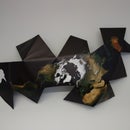Introduction: Cake Icing Tracer Projector
We've previously tried the Frozen Icing-Transfer method with limited success, particularly because the shape was large and complex (breakup while peeling back the parchment).
Attachments
Step 1: What You'll Need
- Pico or Pocket Projector: Prices range from 100$ to 500$ depending on brightness (in lumens) and connectivity. See the link for up date ratings of available projectors.
- 1 bolt: 1/4" diameter, 20 threads per inch. I urge you to bring the projector to a hardware store and test them out. Do be careful not to tighten the bolt too much, because you may break into the projector as can happen with some cameras.
- An old hard drive: I harvested some Neodymium magnets from a dozen of these recently.
- Torx drivers and Philips head screw drivers to get into the hard drive.
- Drill to make a hole for the bolt in the magnet mount.
- Some way to send the photo to the projector like a computer or smart phone with the right adapter. My projector has a slot for Micro SD, so I just copied the JPEGs onto the card.
Step 2: Harvesting the Rare Earth Magnets
Warning, these magnets are VERY powerful and could pinch your fingers or break if you let them snap into each other. I removed about a dozen in an afternoon, and was paranoid that they would start self agglomerating on the table in front of me...
The average household should have 3 old computers gathering dust, if you don't then someone you know does. They are unlikely to be worth anything, so you can go ahead and recycle them: but first, pull out the hard drives and harvest the magnets. All you need is a set of torx screwdrivers (which look like a six pointed star), and maybe some Philips head drivers as well depending on the brand of hard drive. Take off the cover by removing all the screws as well as a few that are likely hiding under stickers or labels. If the cover is not coming off then you likely missed one; rub the labels with the tip of the screwdriver until you find the divot where that last screw was hiding. Once you have the cover off you should find a metal bracket in one corner near the axle for the reader head (see the images). Remove any screws that may be holding the bracket in place and pry off the bracket. It will likely take a screwdriver to get it off because the magnets are very strong. Once you have removed the first magnet, you will see a second one looking back at you. Remove any screw and extract this one too; in fact the bottom one is usually more useful because its bracket is less protruding making it easier to use directly.
Step 3: Create a Mount for the Magnet
I was lucky enough to find a bolt that fit perfectly into the socket of my projector. The magnet is already on a piece of steel we can use to make a mount. The bolt head was thicker than the magnet so I filed it down so that the magnet was flush. I then drilled though the steel bracket, put the bolt through and added a nut to secure it into place. Carefully screw it into your projector; don't overscrew as you may break through into the projector and smash something important.
Step 4: Affix the Projector in Your Kitchen
Warning: you have invested in this gadget, make sure that it is well affixed before letting go. Steel has variable magnetic properties; high quality stainless steel is not very magnetic at all.
You now have enough holding power to hold most pocket or pico projectors onto most steel hardware including a fridge or handles on your cabinets. To make the image larger or smaller, you simply move the projector higher or lower until your image fits your cake. To provide more flexibility you can also try to put two magnets back to back across your cabinet doors; I guess my cabinets are just cheap enough to get away with this... Your power cord and wire feeding the image to the projector are heavy and will want to turn the projector upside down, to resolve this, simply hang the cords over top of the cabinet.

Participated in the
Baking Contest

Participated in the
Workshop Contest

Participated in the
Make It Glow Contest














